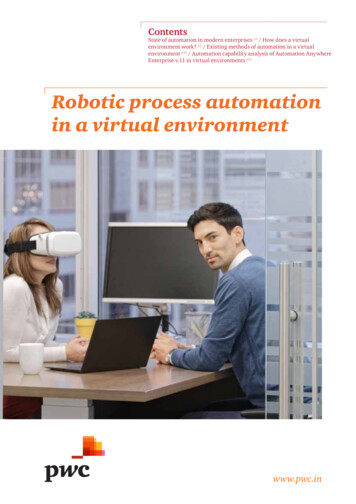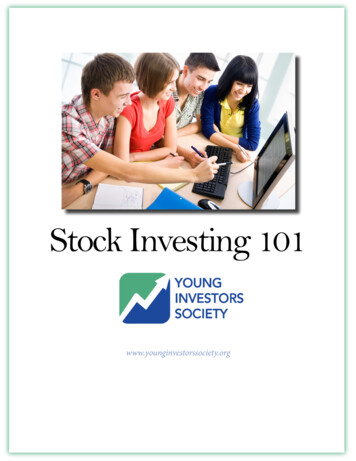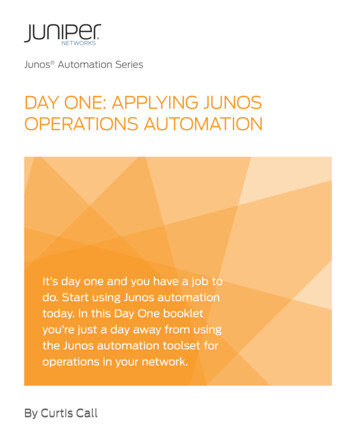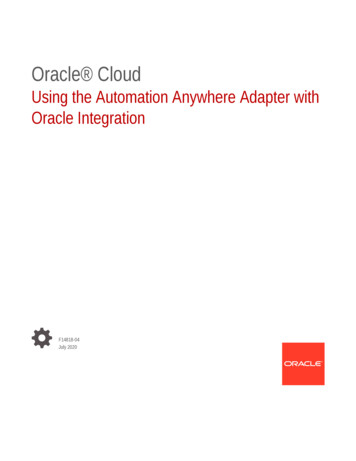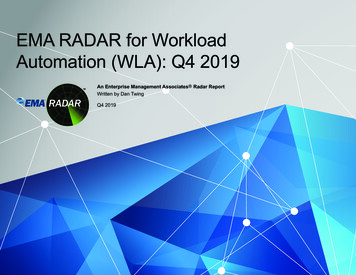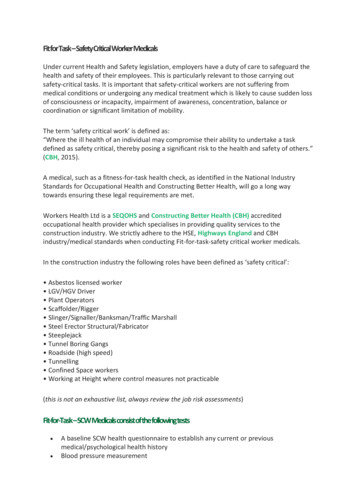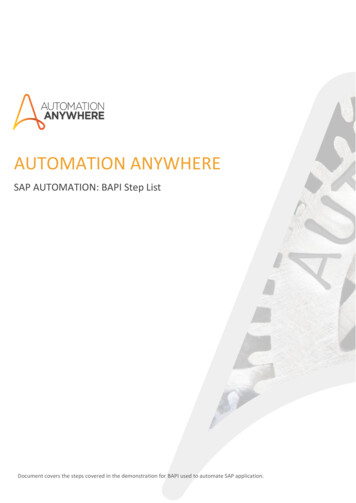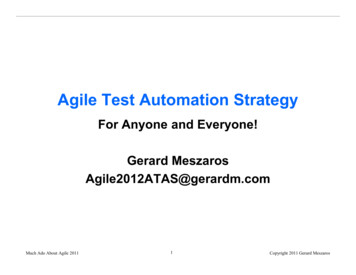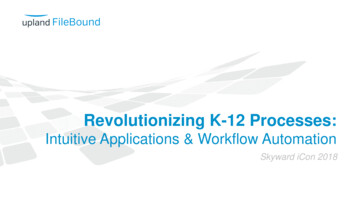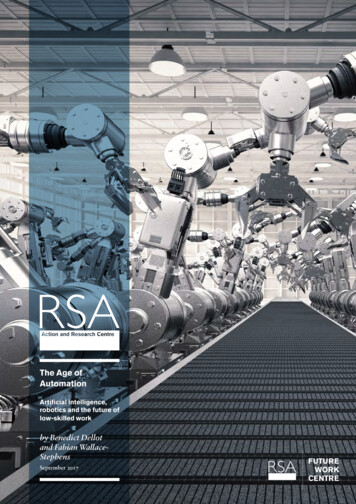
Transcription
The Age ofAutomationArtificial intelligence,robotics and the future oflow-skilled workby Benedict Dellotand Fabian WallaceStephensSeptember 2017
ng AI and robotics17The five dimensions of automation27Sector case studies45Adoption and integration52Automation on our own terms62Conclusion79Methodology81
About the RSAThe RSA (Royal Society for the encouragement of Arts, Manufacturesand Commerce) believes that everyone should have the freedom andpower to turn their ideas into reality – we call this the Power to Create.Through our ideas, research and 28,000-strong Fellowship, we seek torealise a society where creative power is distributed, where concentrationsof power are confronted, and where creative values are nurtured. The RSAAction and Research Centre combines practical experimentation withrigorous research to achieve these goals.About the RSA Future Work CentreThis report is produced by researchers in the RSA’s Future Work Centre– a programme that aims to bring about a better world of work througha combination of rigorous research and practical experiments. Alongsidetrends in automation, we are exploring the rise in self-employment,the nature and characteristics of gig work, and the hidden activities ofthe informal economy. In each case, our work seeks to lead the debateby digging behind the headlines, unpicking the nuance of debates andcanvassing views from across the political spectrum. We believe that goodwork for all is an achievable goal – one that can only be realised throughradical but pragmatic interventions. Over the coming year, the RSA willpublish further content with ideas on how to boost economic security,meaning and dignity in every workplace.AcknowledgementsThe RSA is grateful to Google for sponsoring this research and welcomingan open debate about the impact of technology on society. Special thanksgo to Jon Steinberg, Katie O’Donovan and Lynette Webb for their valuable input. We also thank RSA colleagues for their help, including MatthewTaylor, Anthony Painter, Tony Greenham and Amanda Kanojia, as wellas friends of the organisation who have provided helpful commentary andfeedback, especially Angie Ma and Marc Warner from ASI Data Science.We are grateful to Nic Hinton from Karoshikula for supplying the report’svisuals.The RSA inpartnership with
Foreword‘The Age of Automation’ is an important and timely contribution to thegrowing debate about the impact of technology on work. It encouragesus to look behind the lurid headlines of a workless future and beyond thepolarised debates between utopians and doomsayers. Instead it helps thereader to get to grips with the range of technological change possible andthe very different ways this might impact on a range of types of work,particularly that which tends to be classified as low skilled.Ben and Fabian’s report offers an interesting analysis, namely thatwe are worrying too much about technology but not actually investingenough in is potential. It concludes with a wide ranging and aggregatelyradical set of recommendations which will, I hope, spur further projectsby the RSA.In my recent Review of Modern Employment for Government Ifocussed primarily on the current problems facing the labour market,and particularly those struggling in its lower reaches. But inevitablytechnology featured. One reason we need a fairer and more robustframework for gig work is that the technology underpinning it couldbe – indeed is being – applied to more and more types of employment.Equally, new organising platforms – sometimes called ‘worker tech’ – offeropportunities for contract and self-employed workers to develop forms oforganisation and mutual support.Looking further ahead, we also argued for an approach to technological R and D which emphasised the interaction of machines and humansand an approach to employability which could, in a fast changing labourmarket, better enable people to carry skills and competencies from onejob and area of life to another.The foundation for the whole Review was set by our commitment togood work, or as we put it the goal that ‘all work is fair and decent withscope for fulfilment and development’. I have been pleased to see howwidely that goal has resonated.As this report argues, if we are not to succumb to pessimism or determinism we must keep in mind that technological progress must also behuman progress. The mixture of rigour, pragmatism and idealism is thehallmark of the RSA’s best work. This report meets that expectation fully.Matthew TaylorChief Executive, RSAThe Age of Automation3
SummaryA new machine age beckonsPublic interest in artificial intelligence (AI) and robotics is gatheringsteam – and for good reason. Recent years have seen the emergence ofmachines that can diagnose cancers as accurately as pathologists, detectfraudulent financial transactions in a matter of milliseconds, producecoherent news stories for media outlets, shuttle goods and pallets withincomplex distribution warehouses, trade stocks and shares in financialmarkets, and perform case research for the legal industry. The breadth anddepth of accomplishments expands by the day.It is therefore unsurprising that fears have grown in tandem aboutwhat AI and robotics might mean for workers. It is four years since theUniversity of Oxford published its landmark study predicting that 35percent of UK jobs could be made obsolete by new technology. But sincethen, anxiety about automation has only become more acute. Alarmingnewspaper headlines such as ‘Robots will destroy our jobs – and we’renot ready for it’ and ‘Robots will take a third of British jobs by 2030’ arenow common. So too are the warnings from esteemed technologists andeconomists, such as Elon Musk, Mark Carney and Bill Gates.But are we right to be worried? Are humans destined for the scrapheapas some suggest, or will we find new jobs and niches in a world saturatedby machines? These are the questions we sought to answer in our studyon AI and robotics. In doing so, we have tried to broaden the conversationout from an almost exclusive focus on the number of jobs that might belost, to look at how the nature and substance of jobs are likely to change.This means examining the potential impact of technology on recruitment,pay, progression and productivity, as well as whether it will make jobsmore or less fulfilling and purposeful.Our research has paid particular attention to low-skilled workers, whohave naturally faced greater economic challenges than most. Nearly athird of elementary workers (which includes waitresses and cleaners) havehousehold incomes below the poverty line, as do 22 percent of process,plant and machine operatives. Prospects for progression are also minimal.Barely 1 in 10 workers who were low paid at the beginning of the lastdecade had escaped low pay by the end. Added to this is the growth ofnon-standard forms of employment such as temporary work, agencyarrangements and zero hour contracts, which afford fewer rights andprotections.Job availability: reasons to be hopefulWill AI and robotics make matters worse? They will undoubtedly causethe loss of some jobs, whether it is picking and packing robots that usurpwarehouse workers, or algorithms that take the place of professionals in4The Age of Automation
financial services firms. But there are several reasons to question claims ofmass automation (at least in the short-medium term): Technical limitations – Despite impressive advances in the capability of machines, there are still many things they cannotdo. As entrepreneur and technologist Gary Marcus recently putit: ‘Robots fall over while opening doors, prototype driverlesscars frequently need human intervention, and nobody has yetdesigned a machine that can read reliably at the level of a sixthgrader, let alone a college student.’1.Task vs job automation – In most cases, AI and robotics willautomate individual tasks rather than whole jobs. And becausejobs usually encompass a range of functions, the automation ofone task means workers will be able to pivot into new roles. Nomachine can wholly substitute for retail assistants, care workers,hotel receptionists, warehouse workers or building labourers.These occupations are more likely to evolve than be madeobsolete.Technology complements and creates – AI and robotics will notjust substitute for workers. They will also complement themand create new tasks not previously done by humans. Examplesinclude robotic systems used by overburdened care workers tohelp lift patients, algorithms that enable doctors to recommendmore appropriate treatments, and chatbots that provide callcentre workers with partially automated responses to speed upcustomer support.New jobs will emerge – Some of the fastest growing occupationsin the UK are in the technology industry. The number of programmers has grown by 40 percent since 2011, while the ranks ofIT directors have doubled over the same period. Tech jobs aloneare unlikely to replace those lost to machines, but they will spurjob creation in ancillary sectors. The Berkeley economist EnricoMoretti estimates that every new job in the tech sector has thepotential to generate five complementary jobs elsewhere.Demand will be recycled – Automation must also be looked atthrough a macro lens that accounts for feedback loops. One ofthese is the phenomena of shifting or ‘recycled’ demand. Risingproductivity caused by new machines may lead to a lowering ofprices, thereby freeing consumers to spend money in the samesector or another part of the economy. In cases where demand iselastic (ie goes up and down with prices), automation may notlead to aggregate job losses.While we do not wish to dwell on automation estimates, which are oftenmisleading and superficial, our RSA/YouGov poll of business leaders indicates that 15 percent of private sector jobs in Britain have thepotential to be fully automated in the next decade. However, we foundwide variation among our respondents, with a fifth (22 percent) saying1. Marcus, G. (2017) Artificial intelligence is stuck. Here’s how to move it forward. TheNew York Times, 29 July.The Age of Automation5
they see zero prospect for job automation in the business they work for.Thirty-eight percent predict a low impact (between 1-15 percent of jobsautomatable), 27 percent a medium impact (between 16-30 percent of jobsautomatable), and just 13 percent a high impact (more than 31 percent ofjobs automatable).Regardless of their estimates, most studies reveal a technologicalbias against low-skilled and low-paid workers. Yet some sectors will bemore affected than others. While retail and logistics stand out as highlyautomatable industries, the picture is markedly different for sectors thatare bound up in person-to-person interaction. Just 4 percent of businessleaders in hospitality and leisure, 2 percent in medical and health services,and 3 percent in education see the scope for high automation among theirworkforce (although these last two figures should be interpreted withcaution given low sample sizes)2. This finding is reflected in current jobgrowth rates, with primary and nursery teaching professionals up by 40percent since 2011, and educational support assistants up 50 percent.Job quality: a matter of choicesWe conclude that jobs are more likely to evolve than be eliminated, andthat new occupations will emerge in the long run, often of a more valuable and ‘human-centric’ nature. What is less clear is how AI and roboticswill change the quality of work: Recruitment – Just as new machines will affect the numberof jobs available in the future, so too will they alter the waypeople access that work. Software is coming on stream that canhelp recruiters by screening CVs and analysing gestures andexpressions during interviews. Some believe these algorithmswill entrench existing biases in workforce recruitment, yet othersthink they could eliminate prejudice. AI is also being used topower on-demand platforms, which have been simultaneouslypraised for creating jobs and condemned for diminishing workerrights. Pay – New machines may deskill occupations, thereby loweringbarriers to entry and reducing the bargaining power of workersin existing positions. Deep learning algorithms capable ofdetecting cancers may enable lower skilled nurse practitionersto complete diagnoses that usually take radiologists a decadeto train for, with the latter losing out as a result. On the otherhand, there is evidence that AI and robotics could boost wagesdue to sizeable productivity gains, which will generate moreabsolute wealth that can be shared with workers. Experience – AI and robotics may pave the way for a ‘digitalTaylorism’, with employers using new tools to control theminutiae of workers’ day to day activities. Or technology couldhumanise jobs and phase out dull, dirty and dangerous work.The LSE’s Leslie Willcocks, who has examined the take up of2. Typically, survey results require a sample of at least 50 respondents to be seen asstatistically reliable. Our survey was answered by 37 business leaders in medical and healthservices and 35 business leaders in education.6The Age of Automation
technology in companies such as Associated Press, reports thatin most cases “we found staff not feeling threatened by automation but instead appreciating having fewer repetitive tasks”. Consumer power – AI and robotics will not only affect peopleat work but also in the home – as customers, patients, learnersand political citizens. The experience of history tells us thattechnological advances more often than not supercharge livingstandards, and AI and robotics are almost certain to sustain thistrend. Robo-advisory services in finance will open up financialadvice to more people, AI in healthcare will improve the detection and treatment of diseases, and algorithms used in educationwill enable personalised learning.Quick to criticise, slow to adoptThe message here is that technology is not predetermined to result in aparticular outcome. As a society we have a choice in how to apply AI androbotics and manage their effects. There are choices to be made by developers and engineers in terms of the functionality they imbue in machines,there are choices to be made by employers as to which technologies theypurchase, there are choices to be made by HR teams as to whether andhow they help staff evolve into new roles, and there are choices to be madeby policymakers about the kind of regulatory, welfare and tax system thatcan maximise the upsides of disruption and minimise the downsides.These choices, however, are only relevant so long as the technology isbeing deployed. Indeed, just because a machine can do something, doesnot mean that it will be bought, integrated and licensed to do so. Andherein lies the rub for the UK: while as a society we have been quick tolament the rise of AI and robotics, as an economy we have been slow toadopt these technologies. Sales of industrial robots to the UK fell in theperiod between 2014 and 2015, with the UK purchasing fewer robots thanFrance, the US, Germany, Spain and Italy. Today the UK has just 33 robotunits for every 10,000 employees, compared with 93 in the US and 213 inJapan.These figures must be seen in the context of our smaller manufacturingbase – still the biggest outlet for robotics. But in many sectors the UKhas a poor record of investment. Data from the World Bank shows theproportion of UK GDP accounted for by gross fixed capital formation – ameasure of investment that includes private and public sector spending –has fallen by 7 percentage points since 1990. Our RSA/YouGov poll findsthat just 14 percent of business leaders are currently investing in AI and/or robotics, or plan to in the near future (the figure is just 4 percent forsmall businesses). Many think that the technology is too costly or not yetproven. For others, concepts such as machine learning, deep learning andcloud robotics appear to be completely new.Some may view the slow diffusion of technology as the ideal outcome.It will give society time to adjust. Workers can keep hold of their jobsfor longer. There will be less need to retrain and shift careers. Businesscan carry on as usual. Yet it is worth reminding ourselves what businessas usual means. The status quo is a largely low-skilled, low-paid, lowThe Age of Automation7
productivity labour market that offers too few people the chance toflourish at work. Real median wages are still below their pre-crisis levels –an outcome reflected in our abysmal productivity rates. On average, UKworkers are 30 percent less productive than their counterparts in the US.Our problem is not with the number of jobs available today but ratherwith their quality.Accelerating automation on our own termsThe central argument of this report is that the deployment of AI androbotics could help the UK forge a path towards a better world of work.New technologies could phase out mundane jobs, raise productivitylevels, open up the door to higher wages, and allow workers to concentrate on more human-centric roles that are beyond the technical reachof machines. This is just as true for low-skilled workers as it is for highskilled ones. But we cannot be complacent. AI and robotics, if deployedon a large scale, would result in both losers and winners. Some geographicareas, demographic groups, occupations and sectors would be hit harderthan others. Economic inequality could rise, geographic disparities coulddeepen, and demographic biases could become further entrenched.The challenge, then, is to accelerate the adoption of AI and roboticsbut in a way that delivers automation on our own terms. Our existingpolicy framework appears ill-prepared for this task. Our tax system leanstoo heavily on labour over capital, our welfare structure lacks a sufficientsafety net to protect those who lose out to machines, our educationalinstitutions do not do enough to support lifelong learning that would aidcareer shifts, our inflated housing market prevents people from movingin search of better work, and our investment communities seldom distinguish between supporting benign and malign technologies.But an alternative path exists. While it is beyond the scope of thisstudy to lay out fine-tuned recommendations, we suggest several interventions that would help bring about inclusive automation. Among our ideasare to: Develop an ethical framework to guide the behaviour of AI and robotics engineersEncourage VCs and non-profits to invest in benevolent technology that enriches the worker experienceEstablish a Centre for AI and Robotics that encourages greatertake-up of innovations among industryCreate personal training accounts that aid lifelong learning andhelp workers as they jump from job to jobShift the burden of taxation away from labour and towardscapitalDraft a blueprint for a UK sovereign wealth fund that would giveevery citizen a ‘technological inheritance’.In the frenzy of commentary on automation, it is easy to lose sight of asimple but profound truth: that technology does not arrive out of nowhere, but is humanity’s creation to be wielded as we see fit. It would be atragedy if we were to let a failure of imagination and a dearth of8The Age of Automation
leadership deny us its gifts. AI and robotics promise to extend lifespans,eradicate famine, tackle climate change, and help us manage an ageingpopulation. If there were a question we should be asking, it is not how canwe live with these technologies, but rather how can we live without them?Box 1: Key findings from our RSA/YouGov survey of UKbusiness leadersBusiness leaders on average believe 15% of jobs in their organisation have thepotential to be automated: 22% see zero prospect for automation in their business 38% predict a low impact (between 1-15% of jobs automatable) 27% a medium impact (between 16-30% of jobs automatable) 13% a high impact (more than 30% of jobs automatable).Estimates of high impact automation vary widely by sector:15% of business leaders in retail21% in transport and distribution4% for hospitality and leisure. The adoption rate of AI and/or robotics is low among UK business leaders: Just 14% have already invested in AI and/or robotics, or plan to in the nearfuture 20% say they want to invest but that it will take several years before they will‘seriously’ do so 14% are aware of the technology but believe it is too costly 15% are aware of the technology but do not believe it has been properlytested.Most business leaders take a positive stance towards the arrival of newtechnologies in their sector (including but not limited to AI and robotics): 46% think new technologies are more likely to alter jobs than to eliminatethem, and lead to greater prosperity in the long run 15% think new technologies will lead to the significant automation of jobs,harming livelihoods in the process.There is lukewarm enthusiasm among business leaders for radical policy solutions to technological disruption, although surprising backing for some ideas: 44% back more priority to vocational education and lifelong learning 34% back employee ownership models 31% back a Universal Basic Income.This an abridged account of the full survey results, which can be found in themain body of the report text.The Age of Automation9
IntroductionAutomation anxietyOf all the innovations set to impact the labour market in the 21st century,few have received more attention than robotics and artificial intelligence.Recent books including Rise of the Robots (Ford), Only Humans NeedApply (Kirby and Davenport) and Race Against the Machine (McAfeeand Brynjolfsson) predict these technologies will change the face ofmodern employment, possibly beyond recognition.3. Whether it is driverless cars or surgical robot assistants, banking ‘chatbots’ or self-servicecheckouts, it is now common to hear of how new machines are stepping infor humans at work (a process known simply as ‘automation’).The public reaction has so far been a combination of marvel andtrepidation – feelings that are reflected in popular culture. TV shows andfilms such as Humans, Ex Machina and Automata are both feeding offand fuelling interest in the power and possibilities of AI and robotics.Nor have developments escaped the attention of policymakers. Boththe UK and US governments have investigated the potential impact ofthese technologies on the workforce, and earlier this year a new All PartyParliamentary Group was launched to consider the ramifications of AI.4.Added to these are independent reviews, such as The Future of WorkCommission, led by Tom Watson MP, and the Royal Society’s MachineLearning inquiry.5.Such interest is understandable given the huge sums of money nowflowing into these technologies, the definitions of which we unpack in thenext chapter. The amount of venture capital funding going into roboticsdoubled between 2011 and 2015 to 587m, while the number of mergersand acquisitions of AI start-ups went from 11 in 2012 to 78 in 2016.6.Several of these deals involved UK companies, including DeepMind(bought by Google), SwiftKey (Microsoft) and Magic Pony (Twitter). Theglobal market for robotics and AI-based systems is expected to grow from 58bn in 2014 to 153bn by 2020.7.Four voices on automationNot everyone is in agreement about the consequences for workers.Internet law and policy expert Robert Cannon believes that “everythingthat can be automated will be automated”, while Amazon CEO Jeff Bezos3. Ford, M. (2015) Rise of the Robots. Oneworld Publications; Davenport, T. H. and Kirby,J. (2016) Only Humans Need Apply. Harper Business; and McAfee, A. and Brynjolfsson, E.(2011) Race Against the Machine. Digital Frontier Press.4. For more information, see http://www.appg-ai.org/5. For more information, see http://www.futureofworkcommission.com/6. CB Insights (2016) Robots R’ Us [Research brief] 23 March 2016; and CB Insights (2017)The Race for AI [Research brief] 21 July 2017. CB Insights - tartups-ma-timeline/7. Cited in Government Office for Science (2016) Artificial Intelligence: Opportunities andimplications for the future of decision making. London.10The Age of Automation
claims “It’s hard to overstate how big of an impact [AI is] going to haveon society over the next 20 years”.8. In stark contrast, the new US TreasurySecretary Steve Mnuchin has said the prospect of significant job automation is “not even on my radar screen”. Likewise, the economist RobertSolow has mocked that “the fear of automation is rather like the fear ofcollision with an enormous asteroid.”9.Division in opinion is not limited to a handful of public figures. APew poll of technology and business experts found a 52:48 split betweenthose who believe AI and robotics will create more jobs than they destroy,and those who think the opposite.10. There are also widely differentestimations of how many jobs are likely to be displaced by new machines.Carl Benedikt Frey and Michael Osborne from the University of Oxfordpredicted in 2013 that 35 percent of UK jobs had the potential to be automated, whereas more recent studies put the figure at 10 percent (OECD),5 percent (McKinsey), and 30 percent (PwC).11.Yet whether jobs are likely to be rendered obsolete or not is only onedividing line in the complex debate about technological disruption. Atleast four different camps of opinion on technological change can bediscerned, including those who deny it is even happening on the scalewidely presumed: Alarmists – Alarmists believe in an irresistible march of AI androbotics that will lead to the mass automation of jobs, risinginequality and economic strife – unless imminent action istaken. Writers like Martin Ford acknowledge that technologyhas historically led to new and better jobs in the long-run, butargue that the pace of recent improvements in AI and roboticswill mean that ‘this time is different’: more destruction, lesscreation.12. Many, including Ford and the journalist Ryan Avent,are doubtful that upskilling the workforce will help, pointing asproof to a dwindling number of high-skilled jobs.13. A UniversalBasic Income (UBI) is presented as one solution, possibly paidfor by a ‘tax on robots’, as was recently suggested by Bill Gatesto much controversy.14. Dreamers – Dreamers believe, just as Alarmists do, that newtechnology will lead to the mass automation of jobs. However,their stance is that this could usher in a utopia of a leisuresociety where workers are emancipated from the drudgery anddullness of modern work (a ‘digital Athens’). Instead of railingagainst the machines, Dreamers call for greater investment in8. Robert Cannon quoted in Pew Research Center’s AI, Robotics and the Future of Jobsstudy. Available here: bs/. Jeff Bezos quotedon CNBC news, 31 May 2016. Available here: ai-at-early-stages-of-decades-long-trend.html9. Solow, R. (2013) The End of Work, Again. [article] The European, 25 July 2013.10. Smith, A. and Anderson, J. (2014) AI, Robotics, and the Future of Jobs. Pew ResearchCenter.11. Frey, C. B., Osborne, M. A., and Holmes, C. (2016) Technology at Work v2.0; OECD(2016) Automation and Independent Work in a Digital Economy; and PwC (2017) UKEconomic Outlook: March 2017; and McKinsey Global Institute (2017) A Future that Works.12. Ford, M. (2015) op cit.13. Avent. R. (2016) The Wealth of Humans. St. Martin’s Press.14. Delaney, K. J. (2017) The robot that takes your job should pay taxes, says Bill Gates[article] Quartz, 17 February 2017.The Age of Automation11
technology and for the productivity gains to be used in pursuitof reducing worker hours (or ‘full unemployment’). AlexWilliams and Nick Srnicek, two leading leftwing proponents ofautomation, have, like the Alarmists, called for a Universal BasicIncome, as well as for the use of public funds to ‘democraticallycontrol’ how technology develops.15. Incrementalists – Incrementalists believe AI and robotics aresophisticated technologies, but with a long way to go before theymake humans obsolete at work. They see the force of technologyas a gradual rising tide rather than a fast approaching tidal wave,and believe that new machines are more likely to evolve jobsthan eliminate them. For the writers Julia Kirby and ThomasDavenport, AI and robotics will augment the human workforce,giving the mundane to the machines and the purposeful to thepeople.16. It is up to employers and educators to help workersrespond by ‘stepping up’ or ‘stepping aside’, meaning respectively to find jobs overseeing machines or to find a human-centricpursuit that is resistant to automation, such as in healthcare oreducation.Sceptics– Unlike the other three camps, Sceptics claim that recent innovations – including in the realms of AI and robotics– are mediocre compared with past inventions. In their view, thelow hanging and richest fruits of technology have mostly beenharvested, and only modest innovations remain to be discovered.Among the Sceptics’ founding fathers are Tyler Cowen andRobert Gordon, the latter of which has argued that the inventionof indoor plumbing was more consequential for mankind thanthe advent of the internet.17. As proof of their claims, Scepticspoint to the plateauing of productivity levels around the world, aphenomenon Cowen has labelled ‘The Great Stagnation’.18.Focusing in on the low-skilledEach of these camps has been tussling for position for at least a decade.Yet the debate has been squarely focused on assessing automation’simpact on one group: middle-skilled workers. There is now a broadconsensus among all but the most ardent Sceptics that the labour marketunderwent a form of ‘hollowing out’ during the 1990s and early 2000s,albeit with a subsequent filling in of middle-skilled jobs as other professions plugged the gap.19. According to the Resolut
Automation. Artificial intelligence, robotics and the future of low-skilled work. by Benedict Dellot and Fabian Wallace-Stephens. September 2017. The Age of Automation September 2017. Contents. Foreword 3 Summary 4 Introduction 10 Understanding AI and robotics
